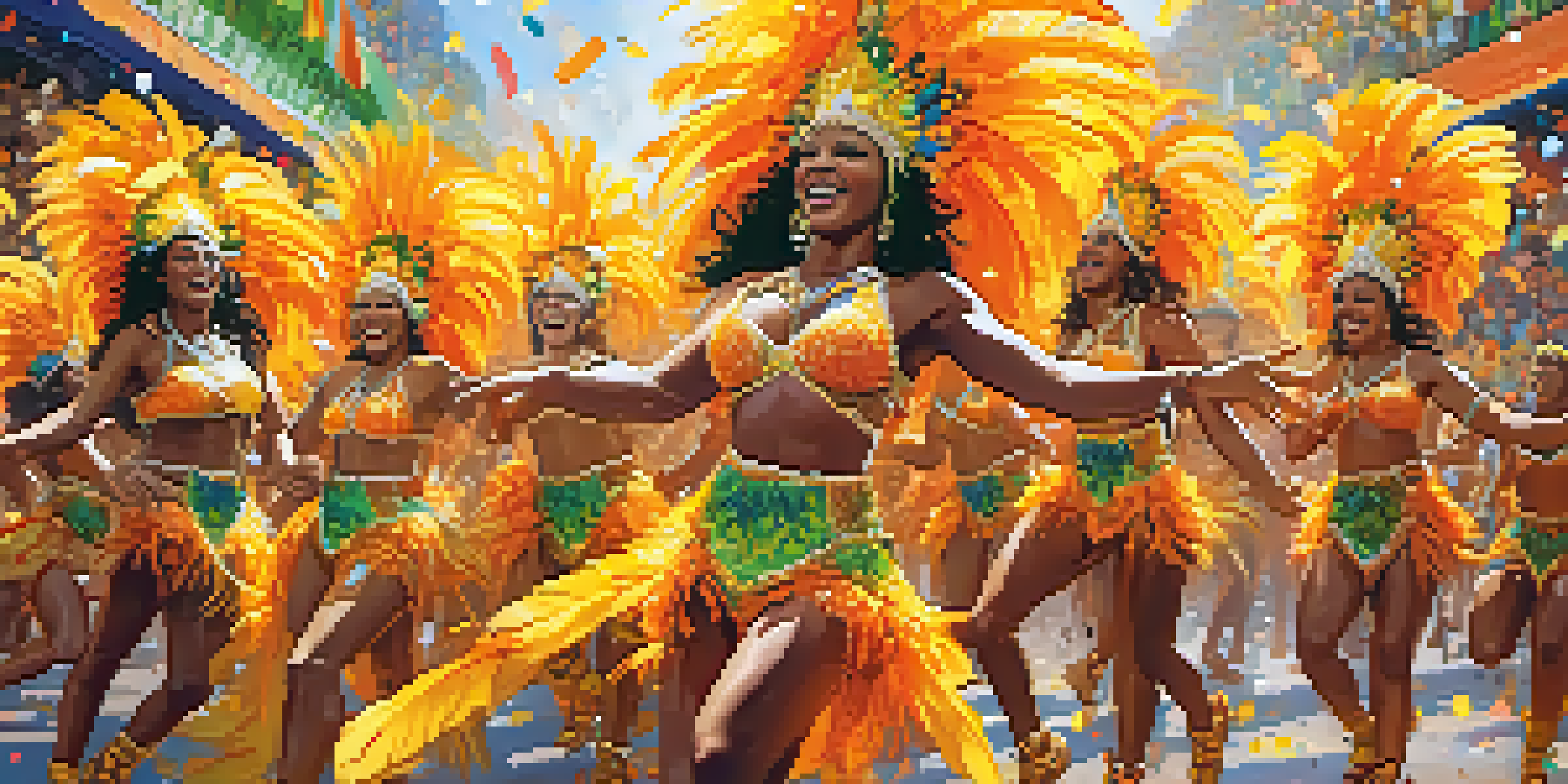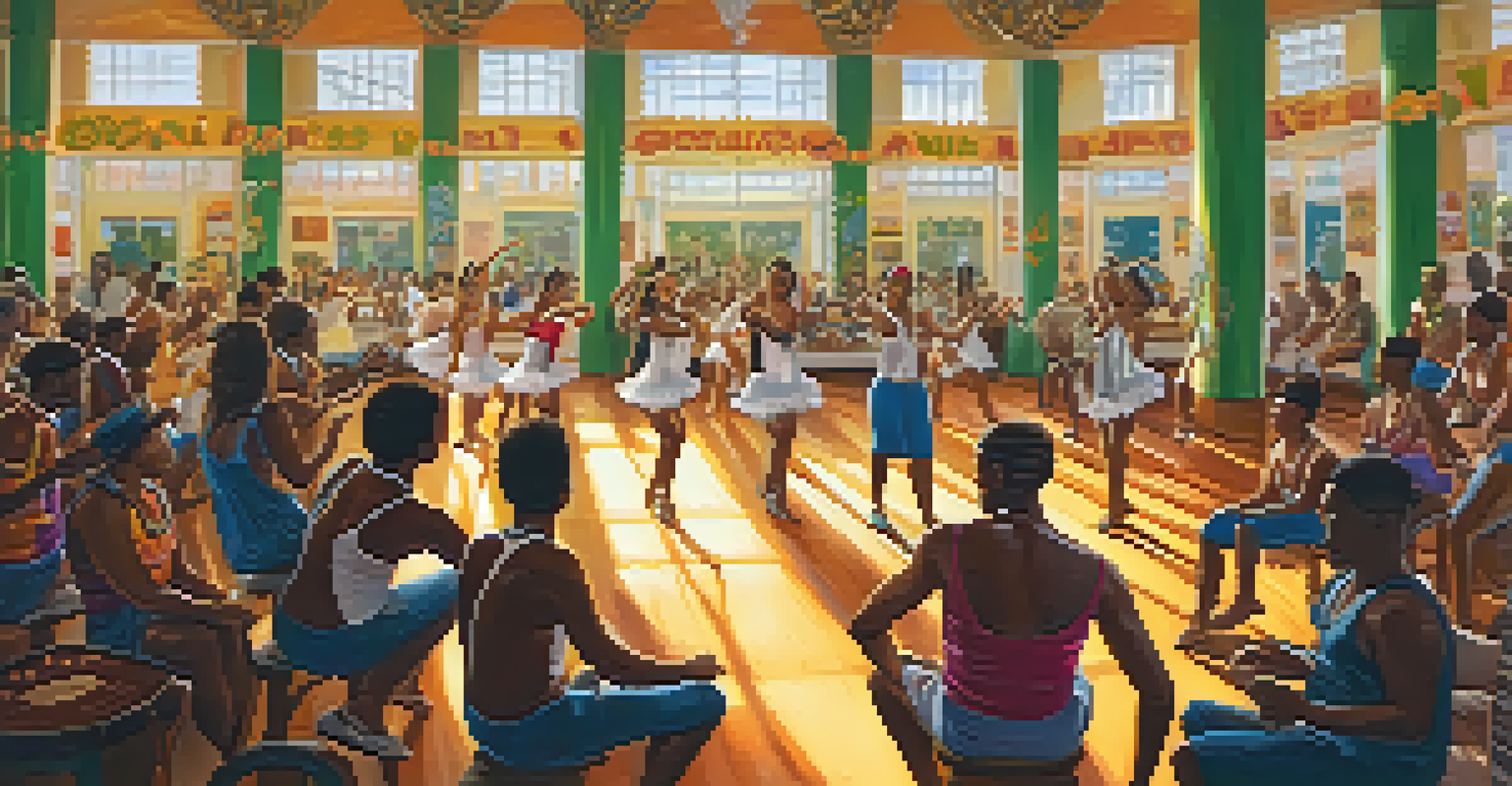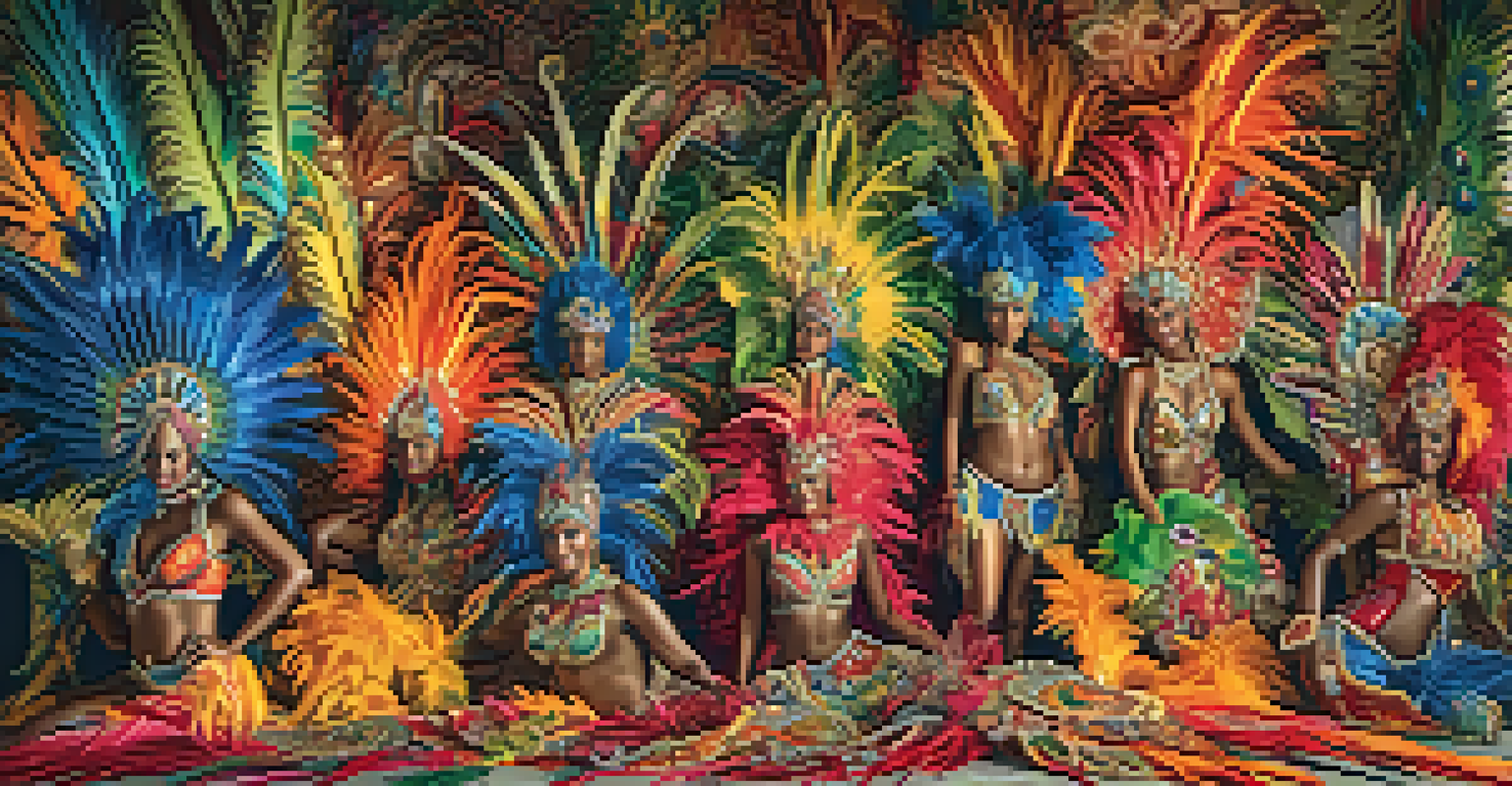Cultural Significance of Samba Schools in Rio de Janeiro

Understanding Samba Schools: More Than Just Dance
Samba schools in Rio de Janeiro are not merely dance troupes; they are vibrant community organizations that embody the spirit of Brazilian culture. Each samba school serves as a hub where people from diverse backgrounds come together to express their creativity and heritage. This communal aspect is essential, as it fosters unity and a sense of belonging among members, often transcending social and economic barriers.
Samba is a way of life that encapsulates resilience and joy.
The schools prepare year-round for the famous Carnival parade, a significant cultural event that attracts millions of spectators. This preparation involves extensive rehearsals, costume design, and music composition, showcasing the dedication and passion of their members. As such, samba schools become a vital part of the city's identity, contributing to the broader narrative of Brazilian culture.
Moreover, samba schools play an educational role, teaching participants about the history and significance of samba music and dance. This education fosters appreciation for cultural traditions and encourages younger generations to engage with their roots, ensuring the samba legacy continues to thrive.
A Historical Perspective on Samba Schools
The roots of samba schools can be traced back to the early 20th century, when samba music emerged from Afro-Brazilian communities. Initially, these schools were informal gatherings where people would share music and dance, but they quickly evolved into structured organizations. This transformation was pivotal, as it allowed samba to gain recognition beyond its local origins, ultimately becoming a symbol of Brazilian national identity.

As samba schools grew in prominence, they began to participate in annual Carnival festivities, where they were judged on their performances. This competitive aspect not only elevated the status of samba but also brought about a sense of pride and ownership among the communities involved. The rivalry between schools has led to an explosion of creativity, with each school striving to outdo the others in terms of costumes, choreography, and thematic presentations.
Samba Schools: Community and Culture
Samba schools serve as vital community hubs that foster creativity, unity, and cultural preservation among diverse members.
Today, samba schools like Mangueira and Portela are household names, celebrated for their historical contributions to the genre. This legacy continues to influence new generations of musicians and dancers, reinforcing the importance of preserving this unique cultural expression.
Samba Schools as Cultural Preservation Hubs
At their core, samba schools act as cultural preservation hubs, safeguarding the traditions and stories of the Afro-Brazilian community. Through music, dance, and storytelling, they keep the rich history of samba alive, allowing members to connect with their ancestry. This preservation is crucial, especially in a rapidly globalizing world where unique cultural identities can be at risk of fading away.
Through music, dance, and storytelling, we keep the rich history of samba alive.
In addition to traditional practices, samba schools integrate contemporary themes into their performances, addressing social issues and current events. This blend of the old and new allows them to remain relevant while still honoring their roots. For instance, many schools have tackled topics like racism, environmental issues, and political corruption through their Carnival presentations.
By engaging with these significant themes, samba schools not only entertain but also provoke thought and reflection among their audiences. This capacity to spark dialogue reinforces the role of samba schools as vital players in both the cultural and social landscape of Brazil.
The Role of Community in Samba Schools
Community is at the heart of samba schools, where members often view each other as family. This sense of belonging fosters strong bonds that extend beyond rehearsals and performances, creating a supportive environment for personal growth and development. Many people find that participating in a samba school helps them build confidence and social skills, which can be life-changing.
Moreover, samba schools often engage in social outreach programs, providing education and resources to underprivileged communities. By offering workshops in music and dance, these schools empower individuals and promote social inclusion. This outreach not only benefits participants but also strengthens the overall community by fostering a culture of collaboration and support.
Economic Impact of Samba Schools
These schools generate significant tourism revenue and create job opportunities, bolstering the local economy while supporting traditional crafts.
Through these initiatives, samba schools demonstrate their commitment to uplifting their communities, proving that their impact goes far beyond the stage. This dedication to service enhances their cultural significance, reinforcing their role as pillars of social change and cohesion.
Samba Schools and Identity Formation
For many participants, being part of a samba school is a powerful means of identity formation. Engaging in samba allows individuals to connect with their cultural heritage and express their unique identities. This connection is especially important for younger generations, who may be navigating their place in a complex and often challenging world.
The performances at Carnival serve as a public showcase of this identity, allowing members to celebrate who they are in front of thousands. It becomes a moment of pride, not just for the performers, but for the communities they represent. This celebration of cultural identity reinforces the idea that samba is more than a dance—it's a way of life that encapsulates resilience and joy.
Furthermore, samba schools provide a platform for exploring and redefining identity. As members come together to create art, they often find common ground despite their differences, fostering a sense of unity that transcends individual backgrounds. This exploration of identity through samba ultimately contributes to a richer, more diverse cultural tapestry.
Economic Impact of Samba Schools
Beyond their cultural significance, samba schools also have a substantial economic impact on Rio de Janeiro. The Carnival celebrations generate millions of dollars in tourism revenue, with samba schools at the center of this attraction. Visitors from around the world flock to the city to witness the vibrant parades, contributing to the local economy through hospitality, transportation, and entertainment.
Moreover, samba schools often collaborate with local businesses, creating job opportunities for artisans, musicians, and performers. This symbiotic relationship boosts the local economy while ensuring that traditional crafts and skills are preserved. By supporting local talent, samba schools play a vital role in sustaining the cultural and economic fabric of the community.
Samba Schools and Identity Formation
Participating in samba schools allows individuals to connect with their cultural heritage and express their identities, fostering a sense of pride and belonging.
Additionally, the exposure that samba schools receive at Carnival can lead to further opportunities for funding and sponsorships. This financial support enables schools to enhance their facilities and programs, ensuring their continued growth and relevance. Ultimately, the economic benefits of samba schools extend far beyond the immediate community, contributing to the vibrant cultural landscape of Brazil.
The Future of Samba Schools in a Globalized World
As globalization continues to shape cultural exchanges, samba schools face both challenges and opportunities. On one hand, the influx of international influences can dilute traditional practices; on the other, it can enrich samba by introducing new ideas and perspectives. Many samba schools are embracing this duality, seeking to innovate while remaining true to their roots.
In recent years, collaborations with international artists have brought fresh energy to samba, allowing it to evolve while still honoring its heritage. This blending of styles has the potential to reach wider audiences, further solidifying samba's place on the global stage. However, it's crucial for samba schools to maintain their authenticity amidst these changes, ensuring that the core values of community and tradition remain intact.

The future of samba schools will likely depend on their ability to adapt and respond to these evolving cultural dynamics. By staying true to their mission of cultural preservation, they can continue to thrive and inspire future generations, ensuring that samba remains a vibrant expression of Brazilian identity for years to come.